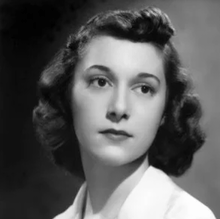Betty Shannon
Betty Shannon (née Mary Elizabeth Moore) (April 14, 1922 – May 1, 2017) was a mathematician and the main research collaborator of Claude Shannon.[1] Betty inspired and assisted Claude in building some of his most famous inventions.[2]
Betty Shannon | |
|---|---|
 Betty Shannon | |
| Born | Mary Elizabeth Moore 14 April, 1922 |
| Died | 1 May, 2017 |
| Nationality | United States of America |
| Education | New Jersey College for Women |
| Occupation | researcher |
| Employer | Bell Labs |
| Spouse(s) | Claude Shannon |
| Children | three |
Life
Shannon was born on April 14, 1922[3] in New York City to Vilma Ujlaky Moore and James E. Moore. She was awarded a full scholarship to the New Jersey College for Women, where she graduated Phi Beta Kappa after studying mathematics.[4]
She worked as a numerical analyst at Bell Labs, where as a computer she supported work on microwaves, and then on radar. She published her own research on "Composing Music by a Stochastic Process"[5]; an "exceptional" accomplishment in an era when it was a "significant and unusual achievement for a woman to get her name on a research report"[4].
While at Bell Labs she met the shy and insular Claude Shannon. Claude "didn’t have much patience with people who weren’t as smart as he was" and the two of them got on well.[2] In 1948 he asked her on a date and they ended up dining each night together; they were married in 1949.[6]
In addition to her research, Shannon was a member of the Weavers' Guild of Boston, served as Dean of the Guild from 1976 to 1978 and received the Guild's Distinguished Achievement Award.[7]
Shannon had three children, Robert James Shannon, Andrew Moore Shannon, and Margarita Shannon, and raised their family in Winchester, Massachusetts. Her oldest son, Robert Shannon, died in 1998 at the age of 45. Betty died on May 1, 2017 at her home at Brookhaven in Lexington, Massachusetts.
References
- Waldrop, M. Mitchell. "Claude Shannon: Reluctant Father of the Digital Age". MIT Technology Review. Retrieved 2017-07-26.
- "Betty Shannon, Unsung Mathematical Genius". Scientific American Blog Network. Retrieved 2017-07-26.
- Jimmy Soni and Rob Goodman, A Mind at Play: How Claude Shannon Invented the Information Age, Simon and Schuster, 2017, ISBN 978-1476766683
- Yu, Haizi; Varshney, Lav R. (December 2017). "On "Composing Music by a Stochastic Process": From Computers that are Human to Composers that are Not Human". IEEE Information Theory Society Newsletter. IEEE Information Theory Society. Retrieved 26 February 2019.
- Pierce, John R.; Shannon, Mary E. (15 November 1949). Bell Telephone Laboratories Technical Memorandum MM-49-150-29. Bell Telephone Laboratories.
- "MIT Professor Claude Shannon dies; was founder of digital communications". MIT News. Retrieved 2017-07-26.
- "MARY ELIZABETH MOORE "BETTY" SHANNON". Boston Globe. Retrieved 2017-07-26.